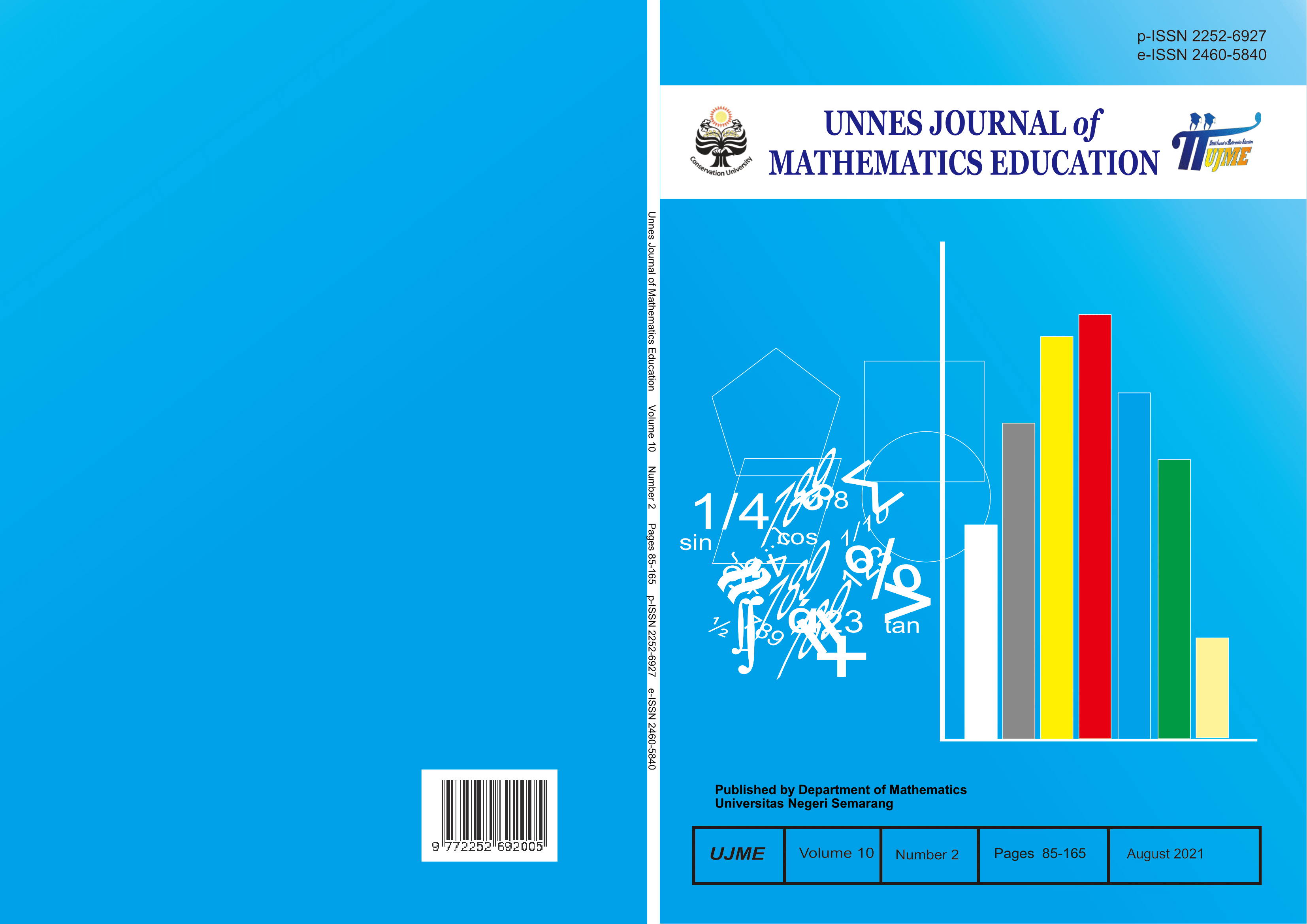Analysis of students mathematics communication ability based on Keirsey personality type through accelerated learning model
##plugins.themes.academic_pro.article.main##
Abstract
Mathematics communication ability needs to be improved so that students can solve math problems well. The purpose of this research was to: (1) determine whether the average students' mathematics communication ability are taught using Accelerated Learning (AL) model reached 65 and finished the classical; (2) describe the mathematics communication ability of students based on personality types Keirsey through the AL model. This research method using mixed methods with sequential explanatory design. Sampling with cluster random sampling technique, the determination of the subject by using purposive sampling. The population in this study is a class VIII student in one of the Junior High Schools in Semarang by taking a class sample. The results showed that the average students' mathematics communication ability are taught using a model of the AL reached 65 and completed the classical with the percentage reached 75%. Description of mathematics communication abilities of students based on Keirsey personality types: (a) Artisan students able to two indicators; (b) Guardian students able to two indicators; (c) Idealist students able to two indicators; and (d) Rational students able to two indicators.
##plugins.themes.academic_pro.article.details##
References
Anthony, G. & M. Walshaw. 2009. Characteristics of Effective Teaching of Mathematics: A View from the West. Journal of Mathematics Education 2(2): 147–164.
Armiati. 2009. Komunikasi Matematis dan Kecerdasan Emosional. Prosiding Seminar NasionAL Matematika dan Pendidikan Matematika. Universitas Pendidikan Indonesia.
DePorter, B. & M. Hernacki. 2016. Quantum Learning: Membiasakan Belajar Nyaman dan Menyenangkan (Alwiyah Abdurrahman, Terj.). Bandung: Kaifa Learning.
Duckworth, A. L. & K. M. Allred. 2012. Handbook of Temperament: Temperament in the classroom. New York: Guilford Press.
Finau, T., D.F. Tragust, M. Won, & A.L. Chandrasegaran. 2016. Effects of a Mathematics Cognitive Acceleration Program on Student Achievement and Motivation. International Journal of Science and Mathematics Education. Australia: Curtin University.
Kementerian Pendidikan dan Kebudayaan. 2014. Peraturan Menteri Pendidikan dan Kebudayaan No. 58 Tahun 2015 tentang Kurikulum 2013 SMP/Mts. Jakarta : Permendikbud RI.
Keirsey, D. 1998. Please Understand Me II. United States: Prometheus Nemesis Books.
Kinard, K. & M. Parker. 2007. The Accelerated Learning Cycle: Are You Ready to Learn? Am I Ready to Lead?. Tallahassee Community College.
Kosko, K. & J. Wilkins. 2012. Mathematical Communication and Its Relation to the Frequency of Manipulative Use. International Electronic Journal of Mathematics Education, 5(2): 1-12.
Kusbiantoro, A., E. Pujiastuti, & Supriyono. 2016. Analisis Kemampuan Penalaran Matematis Peserta Didik SMKN 10 Semarang Kelas X pada Model Pembelajaran Accelerated Learning Berdasarkan Gaya Belajar. Unnes Journal of Mathematics Education, 5(3): 1-7.
Masrukan, B.E. Susilo, & A.D. Pertiwi. 2015. Analysis of Mathematical Communication Ability Through 4K Model Based on 7th Graders’ Personality Types. International Journal of Education and Research, 7(3): 343-352.
Meier, D. 2000. The Accelerated Learning Handbook: A Creative Guide to Designing and Delivering Faster, More Effective Training Programs. America: The McGraw-Hill Companies.
Morgan, C., T. Craig, & M. Schuette. 2014. Language and Communication in Mathematics Education: An Overview of Research in The Field. ZDM Mathematics Education (46): 843–853.
Mulyati, A. 2015. Peningkatan Kemampuan Pemahaman Konsep Matematika dengan Menggunakan Model M-A-S-T-E-R pada Siswa Kelas VIII SMPN 2 Lubuk Basung. Prosiding Seminar Nasional Jurusan PGSD FIP UNP, 1(1).
National Council Of Teachers Of Mathematics. 2000. Principles and Standards for School Mathematics. School Science and Mathematics, 47(8): 868–279.
Pertiwi, A.D. 2014. Analisis Kemampuan Komunikasi Matematis Melalui Pembelajaran Model 4K Berdasarkan Tipe Kepribadian Siswa Kelas VII. Kreano, 5(2): 195-204.
OECD. 2015. Programme for International Student Assessment (PISA).
Putra, J.D. 2014. Penerapan Accelerated Learning dalam Peningkatan Kemampuan Komunikasi Matematis Siswa Sekolah Menengah Pertama. Dimensi, 3(3).
Rose, C. 2003. Accelerated Learning: How memory's secrets unlocked the way to relaxed, easy learning.
Sumartini, T.S. 2017. Meningkatan Kemampuan Komunikasi Matematis Siswa Melalui Model Pembelajaran Predict Observe Explanation. JES-MAT, 3(2): 167-176.
Umar, W. 2012. Membangun Kemampuan Komunikasi Matematis dalam Pembelajaran Matematika. Infinity, 1(1).
Yuwono, A. 2010. Profil Siswa SMA dalam Memecahkan Masalah Matematika Ditinjau dari Tipe Kepribadian. Tesis. Surakarta: Program Pascasarjana Universitas Sebelas Maret.
